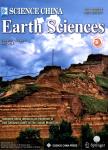Reconstruction of precipitation variation from tree rings in recent 1000 years in Delingha, Qinghai
Reconstruction of precipitation variation from tree rings in recent 1000 years in Delingha, Qinghai作者机构:Institute of Geographic Sciences Natural Resources Research Chinese Academy of Sciences Beijing 100101 China National Climate Center Beijing 100081 China Beijing Normal University Beijing 100875 China
出 版 物:《Science China Earth Sciences》 (中国科学(地球科学英文版))
年 卷 期:2005年第48卷第7期
页 面:939-949页
核心收录:
学科分类:070903[理学-古生物学与地层学(含:古人类学)] 0709[理学-地质学] 07[理学]
基 金:the National KeyBasic Research Development Project of China(Grant No.19980408) the Key Project of Knowledge Innovation of the CAs(Grant No.KZcx2-314) the National Key Project of Science and Technology(Grant No.2001-BA611B-O1)
主 题:northeastern part of the Qaidam Basin tree-ring width series of Qilian juniper precipitation reconstruction in 1000 years.
摘 要:Using seven well-replicated Qilian juniper (Sabina przewalskii Kom.) ring-width chronologies developed at Zongwulong and Shalike Mts. in the northeastern part of the Qaidam Basin annual precipitation from previous July to current June in the recent 1000 years was re- constructed for Delingha. The reconstruction can capture 63.1% of precipitation variance and the equation was stable over time. For the reconstructed precipitation, wet periods occurred in AD1520—1633 and 1933—2001, whereas dry intervals in 1429—1519 and 1634—1741. In ad- dition, the magnitude in precipitation variation was lower before 1430 with about 15 mm, but it increased to 30 mm during the period of 1430 to 1850. After 1850, the precipitation variance de- creased again. In contrast to the increase in temperature, a decrease in annual precipitation was evident since the 1990s. The agreement in low-frequency variation between the reconstruction and the glacier accumulation and particulate content in Dunde ice cores during the recent several hundred years suggested that the precipitation reconstructed in this study was rather reliable, and represented a regional signal. This 1000-year reconstruction could benefit our understanding of climatic variation in decadal to century-scale in this region, and provide basic data to climate models and to prediction of future climate in the 21st century.



